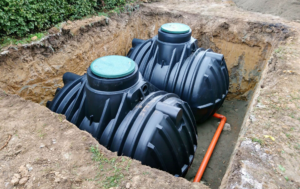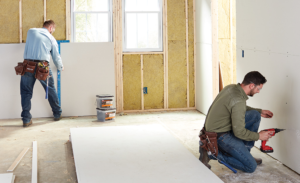Septic tanks are buried, watertight containers made of concrete or fiberglass. They temporarily hold wastewater until bacteria break it down. Heavy solids sink to the bottom and form sludge, while oils and grease float to the top and form scum.
The liquid waste in the middle, called effluent, flows out of the tank into a drain or leach field. Contact Septic Tank Armadale now!

If you notice pooling water on your property, it’s an obvious sign that something is wrong with your septic system. When wastewater leaves your home, it travels through a series of pipes to your drainfield, which is an area of buried soil that filters the untreated wastewater through rocks, dirt, and sand for removal of solids and other contaminants. The excess liquid then seeps back into underground aquifers.
If your septic tank reaches capacity, the solid waste begins to jam the pipes and restricts the flow of liquid waste. If the system isn’t regularly pumped, this can cause wastewater to back up into your home through drains and toilets. In addition, non-biodegradable items thrown down the drains can lead to line clogs and backups. To avoid this, only flush human waste and toilet paper, and place other materials like paper towels, sanitary products, and wipes in the trash or a waste disposal system.
Another sign that your septic system is in trouble is if your drains take longer than usual to empty. This could indicate a blockage in the waste line between the house and septic tank or a clog in the inlet baffle. If you suspect that this is the case, contact a wastewater professional to schedule a service visit.
Foul odors coming from your sinks, toilets, or yard are also an indication that you have a problem with the septic system. These smells are caused by gases such as methane and hydrogen sulfide that build up in the septic tank or drain field. Inhaling these odors can be unpleasant and even dangerous for your health.
Gurgling sounds from your sinks, toilets, and other appliances can also be a sign of a septic system issue. These sounds are created when the system is overflowing or if there’s a clog in the waste line between the house and teepee. It’s important to contact a wastewater specialist right away if you hear these noises, as they can cause significant damage to your plumbing.
Sewage backups are perhaps the most dreaded sign of a septic tank issue. This is because the waste that backs up into your home can be dangerous to your family’s health if inhaled or ingested. If you have a septic system, it’s important to follow maintenance tips to prevent the most serious issues such as sewage backups and foul smells.
Pooling Water
Many people dream about moving from the hustle and bustle of city life to a small home in the country. While a septic system may be an asset to a rural property, it also comes with some added responsibilities. When a septic tank becomes compromised, the waste it holds can back up into your home. This is a serious problem that can require immediate attention from a septic professional.
One of the most obvious signs of a septic tank that is overflowing is pools of water in your yard. Pooling water around your septic tank is a sign that the septic tank is reaching capacity and the solid waste is jamming the system. Pooling water in your yard is not only unsightly, but it can also lead to sewage backups inside your house and cause serious health issues for your family.
Septic tanks work by separating human waste into three different substances: sludge, scum, and wastewater. Sludge and scum are heavy materials that sink to the bottom of the septic tank, while wastewater is lighter and floats to the top. Over time, naturally-occurring bacteria break down the heavier materials and the lighter scum into wastewater that is released into the drain field. If a septic tank is not pumped regularly, the sludge and scum can build up until there is no more room for wastewater. This can lead to a backup of water into your home and even cause flooding in the drain fields and surrounding soil.
Another common sign that your septic system isn’t working properly is a smell of sewage. This can happen if a septic tank’s ventilation system is clogged, which prevents the escape of dangerous gasses. If you notice a strong odor coming from your drains, toilets, or the yard, contact a septic tank expert immediately to schedule a visit.
Leaks and other problems with your septic tank can be avoided by keeping track of what goes down the drains in your home. Avoid flushing wads of toilet paper, chemicals, grease, feminine hygiene products, and other non-organic waste. Planting trees close to a septic tank or leach field can also be harmful, as the roots can easily enter and damage the system. Make sure to plan ahead before planting a tree on your property, figuring out how tall the tree will be at maturity and keeping it at least that far away from the septic tank and leach field.
Odd Noises
While a healthy septic system should be silent, it isn’t impossible for unusual noises to occur. Some of these sounds, like slow trickling water or gurgling sounds, are normal while others signal trouble within your septic system. The best way to know what is going on with your septic tank and septic system is to monitor it from time to time so you can catch problems before they get out of hand.
One of the most common reasons for septic tank gurgling is because it is too full. Having your septic tank pumped at the recommended interval is important so it doesn’t overflow. A septic tank that is too full will struggle to digest solid waste, which can cause sewage to back up into your home. Another reason for septic tank gurgling could be because a clog has prevented the proper flow of air in and out of the tank. This can happen when tree roots wrap around and block the vents of your septic system.
Other issues that can cause septic tank gurgling may include a clogged outlet baffle or effluent filter. If your septic tank is too full and these issues aren’t addressed, it can lead to a clogged drain field that will cause wastewater to back up into your sinks, toilets, and showers.
Odd smells can also signal trouble with your septic tank and system. When your septic tank is full and struggling to process solid waste, this will create a strong odor that may linger throughout your home. This can be even more of a problem when your septic tank has a clog because the trapped odors will likely escape through the vents of your septic system.
A septic system with a working vent will usually make a low humming sound as part of its day-to-day functioning. However, if you hear this sound or another odd smell coming from your home’s plumbing, call your septic service to have it checked out right away. A professional will be able to determine what is causing these strange sounds and smells and make the necessary repairs.
Slow Drains
If your sinks, toilets or tubs are draining slowly — especially if they’re getting slower over time — this is a sign of a problem in your home’s plumbing. Slow drainage usually indicates that there’s an obstruction somewhere along the way from your drain pipe to the septic tank or main sewer line. This could be caused by hair, grease, cigarette butts or other debris that works its way into the pipes. It might also indicate a more serious problem, such as a clog in the main line or septic tank itself.
A septic system allows waste from your home to separate into three different substances: sludge, scum and wastewater. The sludge and scum are heavier and sink to the bottom of the septic tank, while the wastewater floats to the top. Over time, naturally-occurring bacteria will break down the sludge and scum into the wastewater that’s then released into your drain field. If your septic tank gets overloaded, this can lead to wastewater backup in your home. In some cases, it may even cause the drainfield to fail completely.
When you’re experiencing sewage backups inside your home, it’s important to call in a plumber immediately. They’ll likely be able to determine the source of the problem and provide a solution quickly. This may include clearing a blocked vent, fixing a damaged drain or main sewer line, or pumping your septic tank if it’s full.
Bad odors coming from your drains or toilets are another sign that there’s a problem with your septic system. This can occur if there’s an obstruction in your septic system’s ventilation pipe or a clogged vent, if a baffle isn’t working properly or if the septic tank itself has failed.
Whether you’re living in the city or on a piece of rural land, having a septic tank is essential to your home’s plumbing. You can avoid a lot of problems by having regular inspections and performing consistent maintenance tasks. Contact a professional plumbing company, such as High Priority, to schedule an appointment for septic tank services. They’ll conduct a thorough inspection to check for cracks, leaks and other problems and can recommend ways to prevent these issues from happening in the future.


